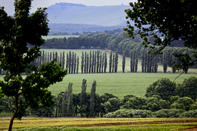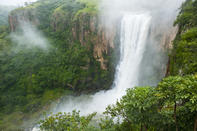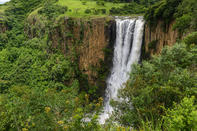Road Meets River
In the KwaZulu-Natal Midlands, just 1 048 m above sea level and midway between the sea and Drakensberg lies the town of Howick. The green, well-watered area is arguably one of the most beautiful parts of Southern Africa.

The beginning of what was to become Howick took place during the middle of the 19th century when the British Government allocated land in the KwaZulu-Natal Midlands. This was in the form of a number of farms. The farms of Oatlands, Woodlands and Stocklands were granted to a Wesleyan missionary, Reverend James Archbell, in April 1849.
Through these lands wound both the Mngeni River and the main road to the interior. The main road, which was a rough wagon track at the time, served as a ford across the river. The ford was situated above an appoximately 95 m high waterfall known amongst locals as kwaNogqaza (place of the tall one), making the crossing extremely dangerous, especially during floods. Despite this, travellers found the area to be rather agreeable due to the fact that it provided an opportunity for their transport animals to graze, rest and drink.
Howick is Created

In November 1850, a plot of land in this area was marked off by the government and named Howick after the home of British colonial secretary, Earl Grey. A ship purser named Lodge was appointed by the British Government to ferry travellers across the river. He put up a small inn close to the river and became the first inhabitant of the town. Early the next year a traveller arrived at Lodge’s Inn, insisting to be taken across the river, despite the river being in flood at the time.
Lodge rowed the man safely across while his horses were given to a servant and Lodge’s 12-year-old son to ride across the flooded river. The servant made it to the other side of the river safely while the horse that the young boy was riding lost its footing and was swept away in the current. Young Lodge was swept over the waterfall and his body was found in a deep pool at its foot. He was buried next to the pool. A small pile of rocks mark his grave.
After that, traffic along the road increased and there were recurrent disasters where the road crossed the river. So much so that in 1872, the government built a wooden bridge to replace the simple ford that served as a passage across the river. This bridge was known as the Bow-String bridge, and it too was unfortunately carried over the waterfall when the river was in flood. Fatalities at the river crossing continued until 1903, when a substantial new bridge was erected.
Fatal Accidents Over the Falls

Although the new bridge made the river crossing much safer for travellers, fatal accidents still occurred. Just two weeks after the opening of the bridge a woman washing clothes was swept over the waterfall. After striking a rock 30 m down, her body became lodged on a ledge 50 m from the top of the waterfall.
After several suggestions were put forward on how to remove the body (this included one advocating the use of dynamite and a round of artillery fire) a soldier named Gunner Mapleson volunteered to remove the body himself. Using his experience as a steeplejack, he suggested a derrick be erected, which he could use to be lowered down to the ledge. After a few tests using rocks, Mapleson descended the waterfall, secured the woman’s body and was hauled back up.
The body was brought up immediately after. In 1906, the first suicide at the waterfall took place when James Kerr threw himself over the edge. This sparked a spate in suicides over the waterfall. In 1940, a schoolboy died when he crashed into the side of the waterfall while attempting to dive over it. Sharp rocks and giant eels in the pool at the foot of the waterfall prevented divers from finding the boy’s body.
Divers did, however, find the remnants of wagons littering the pool’s floor. One wagon was pushed over by workers protesting poor treatment at a local blacksmith shop, another wagon (this one fully intact) had been rolled over in the making of a film called The Voice in 1919.
The body of the boy floated to the surface five days later. There is only one known murder committed over the waterfall. It took place in October 1952, when a gang of drug-runners and burglars flung one of their members over the waterfall’s edge to his death in the pool below.
Two of the culprits were later sentenced to death for their crime. These days, the Howick Falls are visited by thousands of tourists every year and is arguably the most frequently photographed waterfall in South Africa.